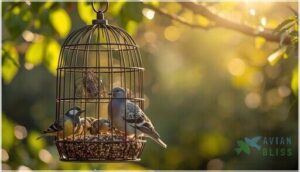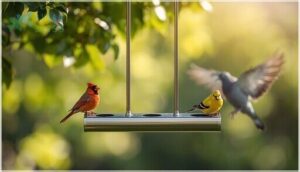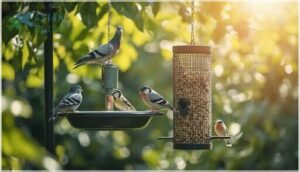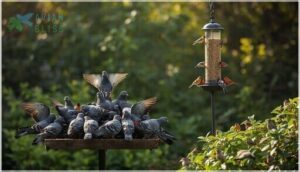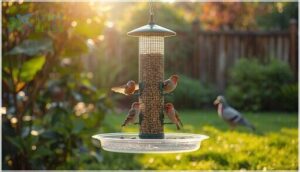This site is supported by our readers. We may earn a commission, at no cost to you, if you purchase through links.

The good news? You don’t need harsh tactics or expensive equipment to reclaim your feeders. A few smart adjustments to your setup—choosing the right feeder style, switching to seeds pigeons can’t stand, and cleaning up spilled food—will tip the scales back in favor of finches, nuthatches, and wrens. These straightforward strategies work because they target what makes pigeons such persistent moochers in the first place.
Table Of Contents
- Key Takeaways
- Why Pigeons Target Bird Feeders
- Choose The Right Pigeon-Proof Bird Feeder
- Select Birdseed That Deters Pigeons
- Prevent Pigeon Access to Spilled Seed
- Effective and Humane Pigeon Deterrent Methods
- Frequently Asked Questions (FAQs)
- How do I keep pigeons away from my bird table?
- How to lure pigeons away from bird feeders?
- Should I buy a pigeon-proof bird feeder?
- Do pigeons eat ground feeders?
- How do I stop pigeons from eating my bird feeder?
- How do I get rid of pigeons but not other birds?
- What do pigeons hate?
- How do you keep pigeons away but not other birds?
- What do pigeons hate the most?
- How do you make a pigeon proof bird feeder?
- Conclusion
Key Takeaways
- You can stop pigeons from dominating your feeders by switching to caged or weight-activated designs that let small birds through but block bulky intruders, cutting pigeon access by up to 95%.
- Pigeons avoid safflower and nyjer seeds due to their bitter taste and tiny size, so swapping out cereal mixes and ground seed for these alternatives attracts songbirds while naturally deterring pigeons.
- Cleaning up spilled seed with catch trays and weekly ground sweeps removes the easy meals that keep pigeons camping out, reducing their visits by around 35%.
- Combining multiple humane deterrents—like reflective objects, bird spikes, and motion-activated repellers—creates a layered defense that can slash pigeon activity by up to 45% without harming them.
Why Pigeons Target Bird Feeders
If pigeons keep flocking to your feeders, you’re not alone. Their feeding habits and knack for outcompeting smaller birds make them tough to manage.
Here’s what attracts them—and what you can do to keep them out.
Pigeon Feeding Habits and Preferences
Regarding pigeons, their foraging behavior is all about opportunity. You’ll notice they favor ground feeding and flock to seed spillage, especially in urban settings. Their dietary composition leans on high-energy seeds—think sunflower hearts and grains. Feeding frequency is steady, with pigeons grazing throughout the day, making them persistent scavengers with clear seed preferences.
Urban pigeons thrive due to abundant food sources.
How Pigeons Outcompete Smaller Birds
You’ve probably noticed pigeons using aggressive feeding habits to muscle out smaller birds at your feeder. Their spatial dominance means they claim flat surfaces, leaving songbirds scrambling for hanging feeders. With behavioral adaptability, pigeons quickly learn new tricks, leading to resource monopolization and even population displacement. Understanding dominance interactions at feeders can help mitigate these issues. Here’s how they take over:
- Pecking and chasing smaller birds
- Clinging to feeders and tables
- Rapid ground feeding
Common Attractants in Your Garden
After pigeons have chased off the smaller birds, they’re drawn to easy meals—think bird seed spilled onto the ground, accessible water sources, and sheltered roosting spots in dense shrubs.
Food sources like cereal mixes or fallen seed boost ground feeding activity. Add in exposed garden waste or open bins, and you’re practically rolling out a welcome mat for persistent pigeons.
Choose The Right Pigeon-Proof Bird Feeder
Picking the right bird feeder makes all the difference for keeping pigeons at bay. Some designs welcome small birds but leave pigeons frustrated.
Here are a few feeder styles that work best for your garden.
Caged Feeders for Excluding Large Birds
Ever wondered why small birds thrive when you use a protective cage? Caged feeders act as a true pigeon guard, blocking bulky intruders with up to 95% cage effectiveness.
Thanks to smart species selectivity and durable structural features, these pigeonproof feeders boost hygiene benefits, cut mold, and lead market trends.
Bird feeder cages offer a simple, lasting solution for your garden’s peace.
Hanging and Tube Feeders With Short Perches
With a hanging bird feeder, you’ll notice perch length benefits right away—short perches make balancing tough for pigeons, but small birds feed with ease. Feeder placement strategies matter too; keep feeders away from ledges to limit pigeon access.
Metal tube feeders offer material durability, while regular maintenance needs like cleaning and seed checks help keep your pigeonproof feeders working smoothly.
Weight-Activated and Mesh Feeders
Smart feeder designs like weight-activated and mesh models bring humane deterrence front and center. You’ll notice fewer pigeons and more songbirds—plus less mess. Sure, Feeder Cost Analysis matters, and Maintenance Requirements need attention, but these feeders stand up to Pigeon Manipulation Attempts.
- Boost Ecological Balance
- Minimize seed loss
- Support humane methods for garden safety
Avoiding Platform and Tray-Style Feeders
With feeder placement, you hold the cards. Platform and tray-style bird feeders act like open buffets for pigeons, making limiting access tough.
Instead, try alternative designs with a height advantage or tray modification to keep pigeons off balance. These deterrents work by reducing ground feeding, letting you reclaim your garden from aggressive flocks without resorting to harsh measures.
Select Birdseed That Deters Pigeons
Choosing the right birdseed can make a big difference in keeping pigeons at bay. Some seeds attract songbirds but aren’t nearly as tempting to pigeons.
Here are a few options to help you strike that balance.
Seeds Pigeons Dislike (Safflower, Nyjer)
Did you know pigeons turn up their beaks at certain seeds? Safflower seeds and nyjer seeds are your best allies. Here’s why they work:
- Safflower benefits: bitter taste deters pigeons.
- Nyjer selectivity: tiny seeds attract finches, not pests.
- Smart seed ratios boost effectiveness.
- Improved feeder hygiene—less mess, fewer pigeons.
Attracting Songbirds With The Right Mix
If you want to see more color and song in your garden, focus on bird seed blends with high sunflower content, safflower, and peanuts. These effective mix ingredients boost songbird attraction rates and feeder compatibility.
Premium mixes also offer better seed nutritional value, supporting species diversity impact. Choosing bird food designed for songbirds means fewer pigeons—and more feathered variety.
Bird Foods to Avoid (Cereal Mixes, Ground Seed)
Ever notice how pigeons flock to feeders packed with cereal grain content and ground seed? That’s no accident—these mixes are a magnet for ground feeding birds, thanks to their seed size preference and high nutritional density.
Avoiding seed fillers like millet and cracked corn cuts down on seed waste and keeps pigeons from turning your bird food into an open buffet.
Prevent Pigeon Access to Spilled Seed
Spilled seed is a magnet for pigeons, turning your garden into their favorite buffet. If you want to keep them from sticking around, it pays to tackle the mess before it starts.
Here are a few practical ways to cut down on easy meals for these persistent birds.
Using Seed Catch Trays
Catching stray seed before it hits the ground is a major advantage for keeping pigeons at bay. Seed catchers boost Tray Design, conserve seed, and support Hygiene Practices. You’ll notice fewer pests, less mess, and real Cost Savings over time. By preventing ground feeding, managing spillage, and reducing pigeon visits, your bird feeders stay cleaner and friendlier for songbirds.
- Seed Conservation
- Pest Reduction
- Improved Hygiene Practices
Regular Cleanup and Maintenance
Cleaning your bird feeders every two weeks with a 10% bleach solution cuts microbial contamination and prevents seed spoilage that draws pigeons. Check for feeder damage monthly and repair broken perches or ports right away.
Remove seed scattered below feeders weekly—this simple step reduces pigeon visits by up to 35%. Adjust practices as needed: fewer refills mean less spillage, better feeder hygiene, and stronger pigeon control methods.
Minimizing Ground Feeding Opportunities
Keep pigeons from exploiting ground-level meals with these smart adjustments:
- Attach seed catchers beneath feeders to trap up to 80% of spilled seed
- Spread mesh or gravel under feeders—pigeons avoid unstable footing
- Create separate zones for ground-feeding birds away from main stations
- Choose enclosed ground feeders with selective access bars
- Sweep daily in high-activity spots
Ground modification strengthens your pigeon control in gardens considerably.
Effective and Humane Pigeon Deterrent Methods
If feeders and seed choices aren’t doing the trick on their own, you can add a few extra layers of protection to discourage pigeons from hanging around. These deterrent methods work by making your yard less comfortable or appealing without causing harm.
Here’s a look at some of the most effective options you can use.
Reflective and Shiny Object Deterrents
You might be surprised to learn that simple shiny objects can act as one of the most powerful visual deterrents against pigeons. Old CDs, reflective rods, or mirrors create moving flashes of light that exploit pigeons’ light sensitivity, reducing their presence by over 99% within an hour.
Reflective objects like old CDs and mirrors exploit pigeons’ light sensitivity, cutting their presence by over 99% within an hour
For lasting results, hang these bird deterrent items where they’ll catch wind and sunlight, and rotate their locations every few weeks to prevent habituation limits from undermining your efforts.
Installing Bird Spikes and Netting
When shiny objects aren’t enough, you can escalate to physical bird deterrent barriers like spikes and netting. Stainless steel spikes reduce pigeon populations by nearly 70% and deliver maintenance-free protection for years. Bird netting offers 100% Pigeon Exclusion Effectiveness when properly installed.
Both Humane Deterrence Impact solutions prevent landing without causing harm, making them ideal deterrents for stubborn pigeons near bird feeders.
Ultrasonic and Motion-Activated Repellers
For humane pigeon management, ultrasonic bird repellers emit high-frequency sounds that make keeping pigeons away easier without harm. Motion-activated models boost sensor sensitivity and cost-effectiveness through targeted activation.
Proper repeller placement—above roosting spots with overlapping coverage—maximizes habituation prevention while deterring unwanted birds. These devices work continuously, offering humane deterrence that protects smaller songbirds at your feeders.
Combining Multiple Deterrent Strategies
When you combine deterrents, you create a layered defense that reduces pigeon activity by up to 45%. This synergistic deterrence approach works better than any single method alone.
Your integrated systems should include:
- Physical barriers (caged feeders, spikes)
- Visual deterrents (reflective objects)
- Seed catch trays for cleanup
- Strategic seed selection (safflower, nyjer)
- Motion-activated repellers
These adaptive strategies deliver cost-effectiveness while deterring unwanted birds humanely at your bird feeders.
Frequently Asked Questions (FAQs)
How do I keep pigeons away from my bird table?
Here’s the bottom line: stop pigeons from scoring free meals by removing ground feeders, installing caged designs, and using deterrents like spikes—DIY pigeon proofing works without relocation.
How to lure pigeons away from bird feeders?
Set up alternate feeding areas away from your main bird feeders using ground feeders filled with cracked corn or cereal mixes.
This seed diversion creates dedicated pigeon zones, discouraging pigeons from targeting areas you’ve reserved for attracting birds.
Should I buy a pigeon-proof bird feeder?
Yes, pigeon-proof feeder designs offer 90%+ effectiveness in discouraging unwanted birds. DIY solutions with pigeon guards work too, but understanding pigeon behavior helps you choose wisely.
Weigh feeder cost against maintenance needs and aesthetic impact.
Do pigeons eat ground feeders?
Unfortunately, pigeons feast on ground feeders like they’ve found a buffet. Their opportunistic feeding behavior means seed spillage becomes an all-you-can-eat invitation, making ground feeder management essential for discouraging birds and deterring pigeons effectively.
How do I stop pigeons from eating my bird feeder?
You’ll need a multi-layered approach: install pigeon guards or caged feeders, switch to seeds they dislike, position feeders away from roosting spots, add humane deterrents, and maintain strict cleanup routines for lasting population control.
How do I get rid of pigeons but not other birds?
The key is selective deterrence through targeted solutions that exploit pigeons’ size and weight. Use caged feeders, weight-activated mechanisms, and specific seed types like safflower—creating peaceful coexistence while protecting smaller birds naturally.
What do pigeons hate?
Pigeons are repelled by loud, high-pitched sounds from acoustic deterrents, strong odors like garlic or peppermint, and visual deterrents such as reflective tape.
Additionally, physical barriers like spikes and behavioral deterrence methods that disrupt their feeding patterns are effective in keeping pigeons away.
How do you keep pigeons away but not other birds?
Your best defense? Selective feeding using safflower or nyjer seeds, pigeon-proof caged feeders, and bird-friendly deterrents like reflective tape.
Smart feeder placement with short perches keeps pigeons grounded while songbirds thrive above.
What do pigeons hate the most?
These birds despise physical barriers like spikes and netting, which prevent landing. They also avoid reflective visual scares, strong scents from citrus or chili, and certain taste aversions.
Effective humane pigeon deterrents combine multiple methods.
How do you make a pigeon proof bird feeder?
Think of your feeder as a fortress. Cage feeder design, mesh opening size (22-28mm), and perch length are crucial factors. Weight-activated technology effectively closes access when pigeons land.
Opt for metal materials and pigeon guards as humane pigeon deterrents.
Conclusion
Studies show pigeons can devour up to 30% of their body weight in seeds daily, making them relentless feeder monopolizers. But you’ve got the tools to flip the script.
By choosing caged feeders, switching to safflower or nyjer seed, and keeping the ground spotless, you’ll create a space where chickadees and finches thrive while pigeons lose interest.
These simple tweaks don’t just solve the problem—they restore your backyard to the colorful, peaceful sanctuary you intended.
- https://birdpact.com/learn/how-to-keep-pigeons-away-from-bird-feeders/
- https://barrie.wbu.com/problem-solving-doves-and-pigeons
- https://www.perkypet.com/articles/5-reasons-to-use-a-caged-bird-feeder
- https://birdseedandbinoculars.com/wordpress/unexpected-birds-in-caged-bird-feeders/
- https://www.allaboutbirds.org/news/how-to-choose-the-right-kind-of-bird-feeder/

